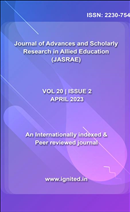The role of GST in Promoting Financial Independence among Women Entrepreneurs
Keywords:
Goods and Services Tax (GST), Women Entrepreneurs, Financial Independence, Tax Compliance, Economic EmpowermentAbstract
The Goods and Services Tax (GST) was implemented in India in July 2017 with the aim of streamlining the taxation system and promoting economic growth. This paper explores the impact of GST on the financial independence of women entrepreneurs. By analyzing secondary data from various sources, including government reports and academic articles, this study examines how GST has influenced business operations, access to credit, and overall financial stability among women-led enterprises. The findings suggest that while GST has simplified tax compliance and improved market access, challenges such as the initial compliance burden and complex filing procedures continue to affect the financial independence of women entrepreneurs.
Downloads
References
Coleman S. (2007). The role of human and financial capital in the profitability and growth of women-owned small firms. J. Small Bus. Manag. 45, 303–319. doi: 10.1111/j.1540-627X.2007.00214.x
Colombier N., Masclet D. (2008). Intergenerational correlation in self employment: some further evidence from French ECHP data. Small Bus. Econ. 30, 423–437. doi: 10.1007/s11187-007-9059-9
Cooper A., Ramachandran M., Schoorman D. (1997). Time allocation patterns of craftsmen and administrative entrepreneurs: implications for financial performance. Entrep. Theory Pract. 22, 123–136. doi: 10.1177/104225879802200209
Cowling M., Taylor M. (2001). Entrepreneurial women and men: two different species? Small Bus. Econ. 16, 167–175. doi: 10.1023/A:1011195516912
Coy S. P., Margaret F. S., Khursheed O., Rao N. A. K. (2011). Factors contributory to success: a study of Pakistan’s small business owners. J. Dev. Entrep. 12, 181–198. doi: 10.1142/s1084946707000617
Delmar F., Gunnsson J.. (1997). Predicting Group Membership among Entrepreneurship, Nascent Entrepreneurs and Non –Entrepreneurs Using Psychological Data and Network Activities, IAREP Conference (Valencia, Spain: Promolibro; ).
Dhahri S., Slimani S., Omri A. (2021). Behavioral entrepreneurship for achieving the sustainable development goals. Technol. Forecast. Soc. Chang. 165:120561. doi: 10.1016/j.techfore.2020.120561, PMID:
Dong J., Xu W., Cha J. (2021). Rural entrepreneurship and job creation: the hybrid identity of village-cadre-entrepreneurs. China Econ. Rev. 70:101704. doi: 10.1016/j.chieco.2021.101704
Dunn T., Holtz-Eakin D. (2000). Financial capital, human capital and the transition to selfemployment: evidence from intergenerational links. J. Labor Econ. 18, 282–305. doi: 10.1086/209959
Fafchamps M., Quisumbing A. (2005). Assets at marriage in rural Ethiopia. J. Dev. Econ. 77, 1–25. doi: 10.1016/j.jdeveco.2004.02.003
Field E., Jayachandran S., Pande R. (2010). Do traditional institutions constrain female entrepreneurship? A field experiment on business training in India. Am. Econ. Rev. 100, 125–129. doi: 10.1257/aer.100.2.125
Fu Q., Abbas J. (2021). Reset the industry redux through corporate social responsibility: The COVID-19 tourism impact on hospitality firms through business model innovation. Front. Psychol. 12:6686.
Gimeno J., Folta T. B., Cooper A. C., Woo C. Y. (1997). Survival of the fittest? Entrepreneurial human capital and the persistence of underperforming firms. Adm. Sci. Q. 42, 750–783. doi: 10.2307/2393656
Gu R., and Nie, F.-y. (2021). Does empowering women benefit poverty reduction? Evidence from a multi-component program in the Inner Mongolia Autonomous Region of China. J. Integr. Agric. 20, 1092-1106. doi: 10.1016/S2095-3119(20)63436-0
Haley C., Marsh R. (2021). Income generation and empowerment pathways for rural women of Jagusi Parish, Uganda: A double-sided sword. Soc, Sci. Humanities Open 4:100225. doi: 10.1016/j.ssaho.2021.100225
Hamilton B. H. (2000). Does entrepreneurship pay? An empirical analysis of the returns to self-employment. J. Polit. Econ. 108, 604–631. doi: 10.1086/262131
Hashemi S. M., Schuler S. R., Riler A. P. (1996). Rural credit programs and women’s empowerment in Bangladesh. World Dev. 24, 635–653. doi: 10.1016/0305-750X(95)00159-A
Helms M. (1997). Women and entrepreneurship: the appealing alternative. Bus. Perspect. 10, 16–19.
Hisrich R. D., Reters M. P. (2004). Entrepreneurship. 5th Edn. (Boston: McGraw-Hill; ).
Hussain T., Abbas J., Wei Z., Ahmad S., Xuehao B., Gaoli Z. (2021). Impact of Urban Village Disamenity on neighboring residential properties: empirical evidence from Nanjing through hedonic pricing model appraisal. J. Urban Plan. Dev. 147:4020055. doi: 10.1061/(ASCE)UP.1943-5444.0000645
Jennings J. E., Brush C. G. (2013). Research on women entrepreneurs: challenges to (and from) the broader entrepreneurship literature? Acad. Manag. Ann. 7, 663–715. doi: 10.5465/19416520.2013.782190
Jonsson P. (2017). On the term “entrepreneur” and the conceptualization of entrepreneurship in the literature of classical economics. Inter. J. Eng. Ling. 7, 8716–8703. doi: 10.5539/ijel.v7n6p16
Kala S. S., Guanghua W. (2010). Firm location choice in cities: evidence from China, India, and Brazil. China Econ. Rev. 21, 113–122. doi: 10.1016/j.chieco.2009.11.003
Karnani A. (2007). The mirage of marketing to the bottom of the pyramid: how the private sector can help alleviate poverty. Calif. Manag. Rev. 49, 90–111. doi: 10.2307/41166407











